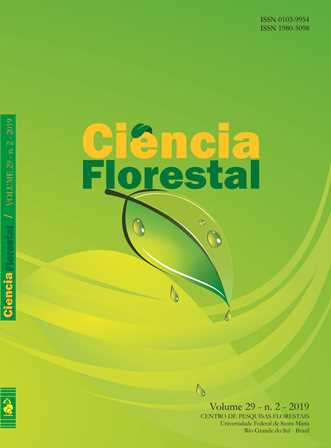Changes in meteorological elements due to the degradation of the urban forest
DOI:
https://doi.org/10.5902/1980509832090Keywords:
Air temperature, Relative humidity, Tijuca forestAbstract
The study of biosphere-atmosphere interactions allows to describe and characterize the main processes of energy and mass transfer related to the particularities of the vegetation. Thus, interactions occurring in a forest can suffer significant impacts due to climate change and changes in land use. That way, the objective of this research was to identify the importance of the degradation of Tijuca forest in the variability of meteorological elements. For this purpose, measurements were made in preserved (-22º95’S, -43º27’W, 445 m) and degraded (-22º95’S, -43º27’W, 445 m) forest area in Tijuca National Park, located in the city of Rio de Janeiro-RJ state. Two automatic meteorological stations were used, and the data collection was from 18th July to 8th September, in 2017, with 30-minute measurement intervals with measurement of the variability of the air temperature the air, relative humidity of the air and precipitation. The data was submitted to the Pearson correlation coeficient, and the test hypotheses t, F and Kolmogorov-Smirnov. The results showed average temperature differences greater than 1°C for the degraded area with a daily range greater than 7°C. The mean relative humidity difference was close to 10%, being lower in the degraded forest. However, in some daily periods, the relative humidity was 30% smaller in the degraded area. The precipitation showed a difference of close to 10% among the areas. The hypothesis tests applied show statistically significant differences showing that there is a significant effect on the meteorological elements analyzed with forest degradation. The degradation of the Tijuca forest contributes to the modification of the local microclimate due to the increase of the air temperature and the relative air humidity reduction.Downloads
References
BOTTALICO, F. et al. Spatially-explicit method to assess the dry deposition of air pollution by urban forests in the city of Florence, Italy. Urban Forestry & Urban Greening, [s.l.], v. 27, p. 221-234, 2017.
BUYANTUYEV, A.; WU. J. Urban heat islands and landscape heterogeneity: linking spatiotemporal variations in surface temperatures to land-cover and socioeconomic patterns. Landscape Ecology, [s.l.], v.25, p. 17-33. 2010.
COELHO NETTO, A. L. A interface florestal-urbana e os desastres naturais relacionados à água no maciço da Tijuca: desafos ao planejamento urbano numa perspectiva sócio-ambiental. Revista do Departamento de Geografa, São Paulo, v. 16, p. 46-60, 2005.
DANTAS, V. A. , SILVA, V. P. R., COSTA, A. C., Chagas, G. F. B. Fluxos de calor no dossel vegetativo e infiltração de água no solo, em floresta tropical. Revista Brasileira de engenharia agrícola e ambiental, [s.l.], v.15, p.1266-1274, 2011.
FRANZBLAU, A. N. A primer of statistics for non statisticians. 1 ed. New York: Harcourt, Brace & World, 1958. 150p.
GAGE, E. A.; COOPER D. J. Urban forest structure and land cover composition effects on land surface temperature in a semi-arid suburban area. Urban Forestry & Urban Greening, [s.l.], v. 28, p. 28-35, 2017.
GALVÃO, J. A. C. Balanço de energia em áreas de floresta e pastejem na Amazônia (Ji-Parana, RO). Revista Brasileira de Meteorologia, [s.l.], v.15, p. 25-37, 2000.
GREEN, R.E. et al. A. Farming and the fate of wild nature. Science, [s.l.], v. 307, p. 550-555. 2005.
MAKHELOUF, A. The effect of green spaces on urban climate and pollution. Iranian Journal of Environmental Health Science & Engineering, [s.l.], v. 6, p. 35-40, 2009.
MARTINI, A.; BIONDI, D. Microclima e Conforto Térmico de um Fragmento de Floresta Urbana em Curitiba, PR. Floresta e Ambiente, [s.l.], v. 22, p.182-193, 2015.
HOWE, D. A. et al. Spatial and temporal variability of air temperature across urban neighborhoods with varying amounts of tree canopy. Urban Forestry & Urban Greening, [s.l.], v. 27, p. 109-116, 2017.
IPCC. Intergovenmantel panel on climate change, 2013. Climate Change. The Physical Science Basis.
KONG, F.; YIN, H.; JAMES, P.; Effects of spatial pattern of greenspace on urban cooling in a large metropolitan area of eastern China. Landscape and Urban Planning, [s.l.], v. 128, p. 35-47. 2014.
PETRALLI, M. et al. Urban planning indicators: useful tools to measure the effect of urbanization and vegetation on summer air temperatures. International Journal of Climatology, [s.l.], v. 34, p. 1236-1244, 2014.
PHELAN, P. E. et al. Urban heat island: mechanisms, implications, and possible remedies. Annual Review of Environnment and Resources, [s.l.], v. 40, p. 285-307, 2015.
PRESS, W.H. et al. Numerical ecipes in C. 3. ed. New York: Cambridge University, 2007, 1195.
SANTOS, J. S. et al. Caracterização do campo térmico urbano e suas relações com o uso e ocupação do solo no Campus Central da UFPB. Revista Brasileira de Geografia Física, [s.l.], v. 3, p. 445-462, 2011.
SHOJAEI, P. et al. Effect of different land cover/use types on canopy layer air temperature in an urban area with a dry climate. Building and Environment, [s.l.], v. 125, p. 451-463, 2017.
SILVA, L. M.; Sá, L. D. A.; Mota, M. U. S. Avaliação de características dos regimes de umidade na flona de Caxiuanã-PA durante o experimento cobra-Pará. Revista Brasileira de Meteorologia, [s.l.], v. 25, p. 1-12, 2010.
STEPHENS, M. A. Use of the Kolmogorov-Smirnov, Cramer-von Mises and related statistics without extensive tables. Journal of the Royal Statistical Society, [s.l.], v.32, p. 115-122, 1970.
TAVARES, A.O.; PATO, R.L.; MAGALHÃES, M.C. Spatial and temporal land use change and occupation over the last half century in a peri-urban area. Applied Geography, [s.l.], v. 34, p. 432-444. 2012.
WANG, M. et al. Assessment of solar radiation reduction from urban forests on buildings along highway corridors in Sydney. Urban Forestry & Urban Greening, [s.l.], v. 15, p. 225-235, 2016.
XIE, J. et al. Environmental control over seasonal variation in carbon fluxes of an urban temperate forest ecosystem. Landscape and Urban Planning, [s.l.], v. 142, p. 63-70, 2015.
YIN, X.; PERRY, J. A.; DIXON, R. K. Influence of canopy removal on oak forest floor decomposition. Canadian Journal of Forest Research, [s.l.], v. 19, p. 204-214, 1989.







